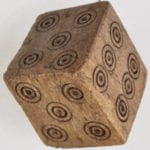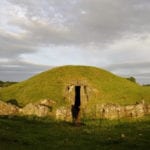 Mysteries
Mysteries  Mysteries
Mysteries  Music
Music 10 Musicians Who Changed How Everyone Plays Their Instruments
 Humans
Humans 10 Inventors Who Died Awful Deaths in Their Own Creations
 Animals
Animals 10 Ways Animals Use Deception to Survive
 Movies and TV
Movies and TV 10 Misdirections Directors Used to Manipulate Actors
 Politics
Politics The 10 Boldest Coup Attempts of the 21st Century
 Weird Stuff
Weird Stuff 10 Things That Would Have Killed You in the Old West
 Books
Books 10 Pen Names More Famous Than Their Authors
 Creepy
Creepy 10 Unnerving Legends from Around the World
 Movies and TV
Movies and TV 10 Amazing Lead Actor Ideas for Superhero Movies
 Mysteries
Mysteries 10 Bizarre, Little-Known Phenomena
 Music
Music 10 Musicians Who Changed How Everyone Plays Their Instruments
 Humans
Humans 10 Inventors Who Died Awful Deaths in Their Own Creations
Who's Behind Listverse?

Jamie Frater
Head Editor
Jamie founded Listverse due to an insatiable desire to share fascinating, obscure, and bizarre facts. He has been a guest speaker on numerous national radio and television stations and is a five time published author.
More About Us Animals
Animals 10 Ways Animals Use Deception to Survive
 Movies and TV
Movies and TV 10 Misdirections Directors Used to Manipulate Actors
 Politics
Politics The 10 Boldest Coup Attempts of the 21st Century
 Weird Stuff
Weird Stuff 10 Things That Would Have Killed You in the Old West
 Books
Books 10 Pen Names More Famous Than Their Authors
 Creepy
Creepy 10 Unnerving Legends from Around the World
 Movies and TV
Movies and TV 10 Amazing Lead Actor Ideas for Superhero Movies
Top 10 Fascinating Museum Exhibits
Museums are not everyone’s cup of tea, but they are essential in the ongoing quest to preserve history for future generations. Museums have also come a long way and many are incorporating technology to make their tours as interactive as possible. Because of the current coronavirus lockdowns, most museums are closed, but many offer amazing virtual tours via their websites.
On this list are some of the most well-known museums in the world and the fascinating exhibits they have to offer.
10 Deep Time
On the first floor of the Smithsonian National Museum of Natural History, a 31,000 square foot fossil hall embodies the theme ‘Deep Time’ and houses one of the biggest exhibits in Washington D.C. The visitor’s journey here begins 4.6 billion years ago, but doesn’t have a definitive end. The Deep Time exhibit reflects on billions of years of science and presents the life-sized fossils of an American mastodon, a woolly mammoth, a giant sloth and many more.
Also included in the Fossil Hall are a total of eight interactive touchscreens that feature videos on ancient climate change and the evolution of the human body.
There is a Fossil Basecamp that feature touchable objects and demonstrations and Fossilab gives visitors the opportunity to see how fossils are prepared for museum exhibits.
The Fossil Hall also includes a Changing Climates section and Age of Humans Gallery that respectively explores the rapid global warming that occurred around 56 million years ago and the effect of humans on the current climate.
9 Calligraphy Gallery
China’s famed Shanghai Museum features over 120,000 ancient Chinese art pieces and features fascinating galleries of Chinese Numismatics, Bronze, Sculpture, Jades, Paintings and many more.
The museum also houses a Calligraphy gallery, an art form that has been practiced for so many centuries that it is considered one of China’s Four Arts to be mastered. The gallery includes the distinctive couplet by artist Jin Nong which perfectly encapsulates the art’s broad style spectrum and shows how well an artist can express themselves through art and language.
In 2020 a temporary display was set up around the calligraphy of Zhao Puchu, who was the president of the Buddhist Association of China from the 50s until his death in 2000. It featured insight into every stage of Zhao’s life and included documents and handwritings. Zhao Puchu was also a world-famous author and poet who lived for helping refugees and regularly assisted with disaster relief.
8 Prehistoric Collection
The National Archaeological Museum of Athens offers a captivating look at ancient Greek life and houses more than 11,000 exhibits that display ancient Greek culture. The museum was founded in 1829, is the largest archaeological museum in Greece and one of the most important in the world in relation to the preservation of ancient Greek art.
The museum includes a collection of Prehistoric Antiquities, including Neolithic, Cycladic and Thera antiquities. These include unique works of art created by major civilizations from the 7th millennium to 1050 BC. Some of the most compelling exhibits in the collection include the Linear B tablets and the treasures of the royal tombs of Mycenae.
7 Museum of Ancient Near East
During air raids over Berlin during the end of WWII, the Pergamon Museum was severely damaged. Fortunately, precautions had been taken and several display objects were stored in safe places while large exhibits were walled in. The loose items were at risk however, and in 1945 the Red Army confiscated them. It took 13 years for most of the items to be returned to Berlin, while some remain in Russia.
Today, the Pergamon Museum is a huge space where reconstructed structures such as the Pergamon Altar and the Mshatta Façade are displayed. Here you will also find The Museum of the Ancient Near East which is spread over 14 rooms and recounts 6,000 years of Middle Eastern history. Visitors can marvel at the Ishtar Gate and the walls of the ancient city of Babylon. Other items include Mesopotamian clay tablets and an alabaster statue.
6 Guggenheim exhibits
The exterior of the Solomon. R. Guggenheim museum contains a small red tile upon which the initials of Frank Lloyd Wright can be seen. Wright designed the building which includes a unique ramp gallery that extends up from the ground level. The museum has sister museums in other parts of the world and houses artworks such as Violin and Palette by Georges Braque, Houses in Paris by Juan Gris and Red Balloon by Paul Klee.
At the Guggenheim you will also find Before the Mirror by Édouard Manet who was determined to upend the historical conventions of art. Morning in the Village after Snowstorm was painted by Kazimir Malevich in 1912 and is one of his most stunning works of art.
Woman with Yellow Hair, painted by Pablo Picasso in 1931, is one of the most well-known pieces at the museum. The subject of the abstract painting is Marie-Thérèse Walter who was Picasso’s mistress and model at the age of 17.
5 Pharaonic antiquities
The Eqyptian Museum was built in 1901 and holds around 120,000 items, some of which are kept in storerooms. The museum boasts the largest collection of Pharaonic antiquities in the world. The building was broken into in 2011 during the Egyptian Revolution and two display mummies were lost. Several other objects were also lost, stolen or damaged only a few of which have been restored.
The museum gallery offers captivating insights into ancient Egypt with displays that include the Gold Mask of King Tutankhamun, the prisoner tiles of Ramesses III, a statue of Hatshepsut and a lot more. On 3 April 2021, twenty-two of the museum’s mummies were transferred to the National Museum of Egyptian Civilization in Fustat. This was done by means of a grand parade called The Pharoah’s Golden Parade.
4 The beginning of the world
In the Cradle of Humankind in South Africa sits the Maropeng Visitor Centre which is a heritage museum that displays fossils found in the area (and other places); fossils from some of the earliest known life forms on Earth. Fossil sites include Bolt’s Farm where fossils dating back 5 million years have been discovered. In Sterkfontein, one of the world’s richest hominid sites, an almost complete Australopithecus skeleton has been found. The Wonder Caves hold fossils of rodents, birds and frogs while Drimolen is the site of 92 hominid specimen discoveries.
The Visitor Centre exhibits explain the beginning of the world and the development of life on Earth. The exhibits include introductions to DNA and evolution and detail the process of extinction. The centre also includes a boat ride through the ‘elements’ of fire, water/ice, earth and air and an explanation of the Gaia Principle.
3 Shrine of the Book
A wing of the Israel Museum in Givat Ram, Jerusalem, is dedicated to the Shrine of the Book which houses the seven Dead Sea Scrolls. The shrine resembles a white dome and has a pool of water surrounding it. The displays include the Isaiah scroll which dates to the 2nd century BC and is the most intact of the scrolls as well as the Aleppo Codex which is the oldest existing Hebrew Bible.
The Temple Scroll is more than 8 meters long and is the longest of the Qumran scrolls, while the Community Rule scroll is believed to have been a rule book for the group of people who wrote the library of scrolls. They are said to have been a strict Jewish sect.
The scrolls are not permanently on display due to their fragile state and are usually exhibited for around 6 months at a time.
2 Piedra del Sol
The National Museum of Anthropology was opened in 1964 and is the largest museum in Mexico. It pays tribute to the indigenous peoples of the country with exhibits that display a host of objects celebrating their lives and cultures.
The extensive collections to be found here include the Preclassic Central Highlands culture, the Cultures of Oaxaca, the Mayan culture as well as Western and Northern cultures.
One of the most magnificent objects to be found at the museum is the infamous Aztec sunstone, Piedra del Sol, that was discovered during repairs of the Metropolitan Cathedral in 1790. The stone weighs around 24 tonnes and its true meaning and purpose remains a mystery. It was carved by the Mexica at the end of the Mesoamerican Postclassic Period and has been on display at the museum since its opening. The center of the stone is believed to depict the face of the solar deity, Tonatiuh while the four squares that surround it represent the four previous suns or eras, namely “Four Jaguar”, “Four Wind”, “Four Rain”, and “Four Water.”
1 The wonders of the British Museum
Dedicated to human history, art and culture, the British Museum holds around 8 million pieces in its collection which makes it one of the largest and most extensive museums in the world. It was also the first public national museum in the world.
There are several departments within the museum that each depict a different part of the world, including Egypt and Sudan, Greece and Rome, the Middle East, Britain, Europe and Prehistoric Asia as well as Africa, Oceania and the Americas.
It is also the location of the famous round Reading Room that saw visitors including Virginia Woolf and Karl Marx as well as Bram Stoker and Sir Arthur Conan Doyle.
At the British Museum visitors can also see the Elgin Marbles, the Mausoleum of Halicarnassus, the Rosetta Stone, the Black Obelisk as well as the Portland Vase. Currently, as the museum is closed due to lockdowns, enthusiasts can take a virtual tour of the ‘Arctic’ exhibit that depicts the culture of the indigenous Arctic Peoples and the dangers that global climate change poses to their home.
Once the museum reopens in May 2021, a temporary exhibit will explore the life and times of Rome’s mad ruler, Nero.








